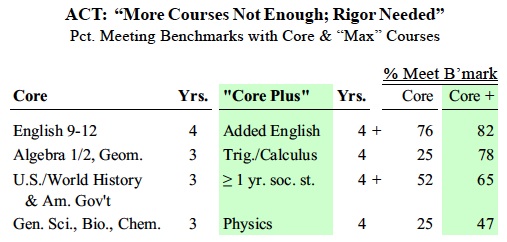Wisconsin Taxpayer’s Alliance [156K PDF Report]:
Wisconsin high school seniors have the second-highest average ACT scores in the U.S. However, ACT finds that only 29% of those tested have a 50% chance of earning a B or a 75% chance of earning a C in each of four college freshman courses: English composition, algebra, social sciences, and biology. Among African-American students, that chance is 4%.
In studying 2007 high school graduates, ACT found that only 29% (boxed in table below) of 46,430 Wisconsin students tested met college-readiness benchmarks in four core subject areas; the national percentage was even lower (23%). In its report “College Readiness: Rigor at Risk,” the ACT testing service concluded that “our high school graduates are in danger of entering college or the workforce without sufficient academic preparation.”
The ACT testing service has urged high schools to offer–and students to pursue–core curricula of sufficient depth and rigor to ensure college success. The minimum core (detailed in the table above, col. 1) includes four years of English and three years each of social studies, math, and science. Unfortunately, ACT has found that the current “quality and intensity–inother words rigor–of the high school curriculum” is not adequate to prepare students for college unless they take courses beyond the core. Calling that “neither realistic nor justifiable,” ACT says it is “essential” that we “improve the quality of core courses that really matter in preparing students for college and work.”
The testing firm goes onto observe that much of the loss in momentum toward college readiness “appears to be occurring during the last two years of high school.” Data in the table support ACT’s concern. The first four columns show the “core” curriculum, as well as a maximal course load (“core plus”) that includes math through calculus. The final two show the percentages of Wisconsin-tested students who met the readiness benchmarks, having pursued one of the two curricula. The need for rigor in all high school courses is reflected in the “collegeready” percentages of Wisconsin students taking four or more years of classes in all areas (“core +”).

Interesting information in this report. Rigor is a real problem, and it’s not getting better with the pressures put on by No Child Left Behind. Most of the emphasis is on the lower performing students, and the result has been a dumbing down of curricula and heterogeneous classrooms that prioritize catching kids up rather than challenging students.
Also, the problem does not lie in the junior and senior years. The problem is at the middle school to high school transition. Middle schools are not preparing students for the amount of rigor they need in high school.
I agree with all of the above except for where the problem of inadequate rigor starts. The problem now starts in the early years of elementary school and continues all the way up. If your kids are already older you may not be aware of what has and is happening in the elementary schools.
Donald:
I think you’re spot on with your comments, particularly the need for more rigor in the middle school years.
The criticism of NCLB is partially to blame, although I do think the law has forced districts to focus much more on student achievement in a systematic way than they did prior to the law’s enactment. But you’re right — NCLB is very much an “over-the-bar” measurement, focused on getting all students to a certain level of achievement (a laudable goal, and one that all districts should strive for), as opposed to raising the bar for all students. The law’s focus is exacerbated in states like Wisconsin with woefully low standards established to meet NCLB targets.
Interestingly, the state’s primary method for getting at this issue — the WKCE series of assessments — is a truly inadequate tool for getting at better achievement results. Ironically, state education and public policy officials (so far) have shown little interest in adopting the very tools (the ACT and its middle-school cousins, PLAN and EXPLORE) highlighted in this report that can effectively be used by districts to improve student achievement at all levels (low-performing and high-performing students). Illinois (a state much derided in Wisconsin education circles), Michigan and Colorado among others now require all students to take the ACT, with some telling results on how that’s impacting middle school and early high school performance. But Wisconsin seems wedded to its faulty WKCE assessment, and bragging out the self-selected students who do well on the ACT (motivated, perhaps, by their desire to get into selective colleges).